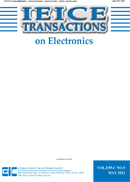
- |<
- <
- 1
- >
- >|
-
Yoshiki KAYANO2020 Volume E103.C Issue 12 Pages 697
Published: December 01, 2020
Released on J-STAGE: December 01, 2020
JOURNAL FREE ACCESSDownload PDF (69K) -
Yuta KANEKO, Junya SEKIKAWAArticle type: PAPER
2020 Volume E103.C Issue 12 Pages 698-704
Published: December 01, 2020
Released on J-STAGE: December 01, 2020
Advance online publication: July 03, 2020JOURNAL RESTRICTED ACCESSSilver electrical contacts were separated at constant opening speed in a 200V-500VDC/10A resistive circuit. Break arcs were extinguished by magnetic blowing-out with transverse magnetic field of a permanent magnet. The permanent magnet was appropriately located to simplify the lengthened shape of the break arcs. Magnetic flux density of the transverse magnetic field was varied from 20 to 140mT. Images of the break arcs were observed from the horizontal and vertical directions using two high speed cameras simultaneously. Arc length just before extinction was analyzed from the observed images. It was shown that shapes of the break arcs were simple enough to trace the most part of paths of the break arcs for all experimental conditions owing to simplification of the shapes of the break arcs by appropriate arrangement of the magnet. The arc length increased with increasing supply voltage and decreased with increasing magnetic flux density. These results will be discussed in the view points of arc lengthening time and arc lengthening velocity.
View full abstractDownload PDF (2242K) -
Koichiro SAWA, Yoshitada WATANABE, Takahiro UENO, Hirotasu MASUBUCHIArticle type: PAPER
2020 Volume E103.C Issue 12 Pages 705-712
Published: December 01, 2020
Released on J-STAGE: December 01, 2020
Advance online publication: June 08, 2020JOURNAL RESTRICTED ACCESSThe authors have been investigating the deterioration process of Au-plated slip-ring and Ag-Pd brush system with lubricant to realize stable and long lifetime. Through the past tests, it can be made clear that lubricant is very important for long lifetime, and a simple model of the deterioration process was proposed. However, it is still an issue how the lubricant is deteriorated and also what the relation between lubricant deterioration and contact voltage behavior is. In this paper, the contact voltage waveforms were regularly recorded during the test, and analyzed to obtain the time change of peak voltage and standard deviation during one rotation. Based on these results, it is discussed what happens at the interface between ring and brush with the lubricant. And the following results are made clear. The fluctuation of voltage waveforms, especially peaks of pulse-like fluctuation more easily occurs for minus rings than for plus rings. Further, peak values of the pulse-like fluctuation rapidly decreases and disappear at lower rotation speed as mentioned in the previous works. In addition, each peaks of the pulse-like fluctuation is identified at each position of the ring periphery. From these results, it can be assumed that lubricant film exists between brush and ring surface and electric conduction is realized by tunnel effect. In other words, it can be made clear that the fluctuation would be caused by the lubricant layer, not only by the ring surface. Finally, an electric conduction model is proposed and the above results can be explained by this model.
View full abstractDownload PDF (4110K) -
Yoshiki KAYANO, Kazuaki MIYANAGA, Hiroshi INOUEArticle type: BRIEF PAPER
2020 Volume E103.C Issue 12 Pages 713-717
Published: December 01, 2020
Released on J-STAGE: December 01, 2020
Advance online publication: July 03, 2020JOURNAL RESTRICTED ACCESSIn the design of electrical contacts, it is required to pursue a solution which satisfies simultaneously multi-objective (electrical, mechanical, and thermal) performances including conflicting requirements. Preference Set-Based Design (PSD) has been proposed as practical procedure of the fuzzy set-based design method. This brief paper newly attempts to propose a concurrent design method by PSD to electrical contact, specifically a design of a shape of cantilever in relay contacts. In order to reduce the calculation (and/or experimental) cost, this paper newly attempt to apply Design of Experiments (DoE) for meta-modeling to PSD. The number of the calculation for the meta-modeling can be reduced to $\frac{1}{729}$ by using DoE. The design parameters (width and length) of a cantilever for drive an electrical contact, which satisfy required performance (target deflection), are obtained in ranges successfully by PSD. The validity of the design parameters is demonstrated by numerical modeling.
View full abstractDownload PDF (1540K)
- |<
- <
- 1
- >
- >|